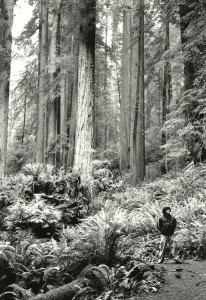Entre los Gigantes: On Latino Experiences among the Redwoods and Sequoias

By Jose Gonzalez, NewsTaco
There is a certain fortune in being able to live in California and having the opportunity to visit los arboles grandes, los gigantes—the redwoods and sequoias. But it is a gift that some take for granted, or assumed that it is equitably accessed.
Growing up in the California Central Valley, visiting the redwoods was not a regular opportunity our family could take. We were a low-income immigrant Latino family. Not to generalize, but our weekend outdoor venturing, though numerous enough, was centered on local city and county parks. These trips were very recreational in intent, focused on carne asada, games of volleyball, and swimming in the river, which mirrors some of the research.
To take a visit to a park that was a protected area was a different frame of mind and experience—a frame of mind that I think is easy enough to understand from a middle-class Anglo background, but not always as easy from a low-income Latino working class experience.
That is not to say that it makes us ignorant, unappreciative, or unable to have that frame of mind, but I say it to stress the point that we can come from different starting points.
Furthermore, the idea of redwoods and Latinos is not one that intuitively comes to mind. Yet, there are connections made every day between Latinos and these giants, and as we look into the history we see even more.
Some of the first European accounts of the redwoods and sequoias came from Spanish explorers and settlers. One account, by Don Gaspar de Portola, notes how they saw “árboles muy altos de un color rojo“, tall trees of red color. No one had seen trees like these and so they called them “palo colorado“, redwood.
To this day you see the hints of this history in the names of places, for example, Palo Alto, “Tall Tree”, home of Stanford University and a hub of Silicon Valley.
I do not recall the exact first time I saw one set of giants, the giant sequoias in the Sierra Nevada. I believe it was as part of a school trip or because my family had wandered into the foothills looking for a place to play in the snow. But I do recall wondering how these trees grew so big and why I did not see them where I lived, in the flatlands of the valley. ¿Por qué tan grandes y por qué aquí? I imagine that could be a similar sense of wonder and curiosity of the first Spanish.
Nowadays, Latinos are poised to be the largest ethnic group in California and key to continued redwood and sequoia conservation will be for Latinos to see these unique natural wonders as part of their heritage and worth protecting, to understand them and know that they have a hand and responsibility to continue their care.
Latinos are already living in Redwood areas and growing. We are getting out there, but there are still concerns that we are no accessing these public lands in the same way, or with the same opportunities are other socioeconomic groups. Rather, like many communities of color, we are lagging behind.
There have been efforts, usually in partnership with mainstream conservation organizations and will calls related to health.
It is important to recognize those as starting points because they matter to our communities: cleaner air, healthier families, cleaner water, and so forth.
But I also want us to get to similar end points where we can enjoy these natural treasures and experience the magic of being among these gigantes.
Anglo or higher-income communities can routinely have those magic moments of being in the redwoods.
Latinos can and do have them as well. The trick is not in leaving us at the starting points or rushing us to the end. Sometimes, well intentioned efforts forget we may need to start at a different experience. Then there is the need to provide positive experiences that guided us to those end points. Often groups may forget that and try to rush everyone to be where they are—killing a bit of the magic along the way.
Embedded into my first experiences with giant sequoias and redwoods was the idea that these trees were special, different from other trees, and they needed protection. But part of it felt like going to a museum—I could admire what I was looking at but needed to keep a respectful distance. It was something to go see.
It was on a later trip to Redwood National Park where I recall really experiencing what to me is the magical realism of walking through these cathedrals of trees. These giants were real and yet seemed to be magic, reaching out to me beyond a physical experience and from such distance in the past.
As a true heritage, a visit to the redwoods and sequoias should be something that we all should see, regardless of socioeconomic status or skin color. We should learn more about how to protect and conserve them, along with the fascinating information that fills books and visitors displays.
But we should not just visit a park with a removed sense of seeing something on display. If we can connect with ourselves, and connect ourselves to where we are, then we open a window to appreciate such natural gifts, and hopefully see what responsibility rests in our hands.
These amazing giants have lived for so long, some thousands of years. As Latinos we need to be to understand what puts them at risk, why do they matter, how are they protected and what needs to be sustained. But it can start with a visit, and making sure we know and have an opportunity to access them.
[Photo by Jose Gonzalez]

